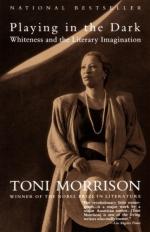
|
| Name: _________________________ | Period: ___________________ |
This test consists of 15 multiple choice questions and 5 short answer questions.
Multiple Choice Questions
1. What does Morrison describe Sapphira and the Slave Girl as being an example of?
(a) Willful critical blindness.
(b) Urgency in American literature.
(c) Fulfilling language and lackluster art.
(d) Immediate Africanist presence.
2. What does Cardinal's first therapy realization concern?
(a) Sexuality of different races.
(b) Music started her fall to madness.
(c) Dichotomy thrust upon people of color.
(d) Prepubescent sensuality.
3. Which of the following words does Morrison use to describe writers?
(a) Lustrious.
(b) Telling.
(c) Probing.
(d) Angry.
4. Which group, according to Morrison, is more likely to claim that racism is neutral?
(a) Africans.
(b) Americans.
(c) Europeans.
(d) Asians.
5. Morrison says that what item reveals itself differently to each writer?
(a) Pen.
(b) Paper.
(c) Book.
(d) Notebook.
6. Which word best describes Sapphira?
(a) Desperate.
(b) Benevolent.
(c) Wicked.
(d) Intelligent.
7. According to Morrison, what do readers and writers fight for?
(a) Defintion and defiance.
(b) Determination and fear.
(c) Meaning and responsibility.
(d) Individuality and duality.
8. Who is the author of Possession?
(a) Antonia Byatt.
(b) Arthur Brown.
(c) Ashley Bassat.
(d) Anthony Beccket.
9. When was a criticism written deeming the term "darky" acceptable?
(a) 1951.
(b) 1936.
(c) 1956.
(d) 1942.
10. Until recently, what did Morrison assume about all readers of American fiction?
(a) They are men.
(b) They are raceless.
(c) They are women.
(d) They are white.
11. Who is Sapphira jealous of?
(a) Her sister.
(b) Her slave.
(c) Her mother.
(d) Her daughter.
12. What is "the Thing"?
(a) Cardinal's illness.
(b) Classic literature.
(c) Morrison's distaste for Africanist literature.
(d) Louis Armstrong concert.
13. How many pages into The Words to Say It does "the thing" happen?
(a) 80.
(b) 10.
(c) 120.
(d) 40.
14. Where were the lectures that Playing in the Dark is based on given?
(a) University of Washington.
(b) Princeton.
(c) UCLA.
(d) Harvard.
15. What are references to Sapphira and the Slave Girl noted as being?
(a) Demeaning.
(b) Apologetic.
(c) Spiteful.
(d) Lackluster.
Short Answer Questions
1. What does Morrison say produces work?
2. What does Morrison teach?
3. Who is the second author Morrison mentions as including black references in his or her work?
4. What is the name of Sapphira's slave?
5. Where did Cardinal grow up?
|
This section contains 322 words (approx. 2 pages at 300 words per page) |

|




